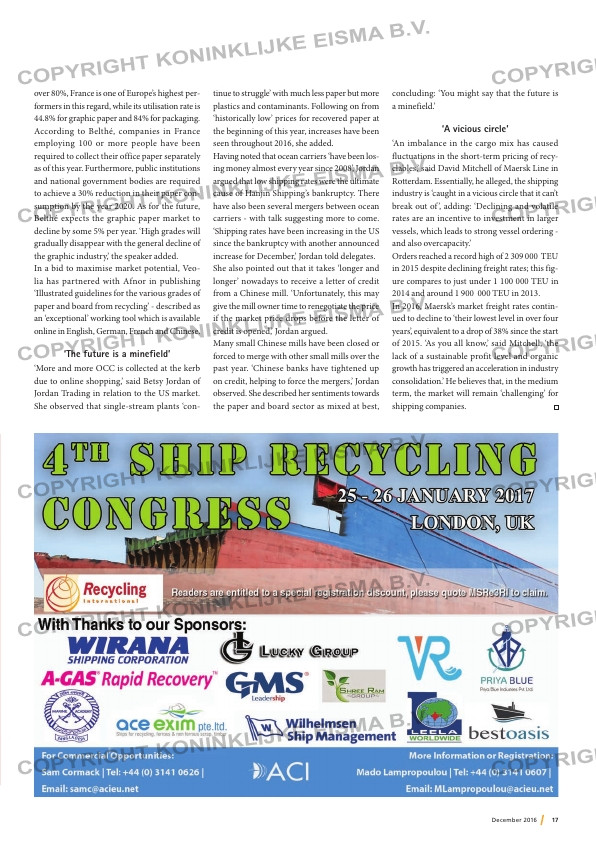Page 17 from: December 2016

17December 2016
over 80%, France is one of Europe’s highest per-
formers in this regard, while its utilisation rate is
44.8% for graphic paper and 84% for packaging.
According to Belthé, companies in France
employing 100 or more people have been
required to collect their office paper separately
as of this year. Furthermore, public institutions
and national government bodies are required
to achieve a 30% reduction in their paper con-
sumption by the year 2020. As for the future,
Belthé expects the graphic paper market to
decline by some 5% per year. ‘High grades will
gradually disappear with the general decline of
the graphic industry,’ the speaker added.
In a bid to maximise market potential, Veo-
lia has partnered with Afnor in publishing
‘Illustrated guidelines for the various grades of
paper and board from recycling’ – described as
an ‘exceptional’ working tool which is available
online in English, German, French and Chinese.
‘The future is a minefield’
‘More and more OCC is collected at the kerb
due to online shopping,’ said Betsy Jordan of
Jordan Trading in relation to the US market.
She observed that single-stream plants ‘con-
tinue to struggle’ with much less paper but more
plastics and contaminants. Following on from
‘historically low’ prices for recovered paper at
the beginning of this year, increases have been
seen throughout 2016, she added.
Having noted that ocean carriers ‘have been los-
ing money almost every year since 2008’, Jordan
argued that low shipping rates were the ultimate
cause of Hanjin Shipping’s bankruptcy. There
have also been several mergers between ocean
carriers – with talk suggesting more to come.
‘Shipping rates have been increasing in the US
since the bankruptcy with another announced
increase for December,’ Jordan told delegates.
She also pointed out that it takes ‘longer and
longer’ nowadays to receive a letter of credit
from a Chinese mill. ‘Unfortunately, this may
give the mill owner time to renegotiate the price
if the market price drops before the letter of
credit is opened,’ Jordan argued.
Many small Chinese mills have been closed or
forced to merge with other small mills over the
past year. ‘Chinese banks have tightened up
on credit, helping to force the mergers,’ Jordan
observed. She described her sentiments towards
the paper and board sector as mixed at best,
concluding: ‘You might say that the future is
a minefield.’
‘A vicious circle’
‘An imbalance in the cargo mix has caused
fluctuations in the short-term pricing of recy-
clables,’ said David Mitchell of Maersk Line in
Rotterdam. Essentially, he alleged, the shipping
industry is ‘caught in a vicious circle that it can’t
break out of ’, adding: ‘Declining and volatile
rates are an incentive to investment in larger
vessels, which leads to strong vessel ordering –
and also overcapacity.’
Orders reached a record high of 2 309 000 TEU
in 2015 despite declining freight rates; this fig-
ure compares to just under 1 100 000 TEU in
2014 and around 1 900 000 TEU in 2013.
In 2016, Maersk’s market freight rates contin-
ued to decline to ‘their lowest level in over four
years’, equivalent to a drop of 38% since the start
of 2015. ‘As you all know,’ said Mitchell, ‘the
lack of a sustainable profit level and organic
growth has triggered an acceleration in industry
consolidation.’ He believes that, in the medium
term, the market will remain ‘challenging’ for
shipping companies.
The Recycling International team wishes you
Happy Holidays
And a prosperous 2017
In
st
ea
d
of
s
en
di
ng
o
ut
c
hr
is
tm
as
c
ar
ds
w
e
w
ill
m
ak
in
g
do
na
ti
on
s
to
c
ha
rit
y
or
ga
ni
sa
ti
on
.
©
Fo
to
lia
/ M
at
th
ia
s
En
te
r



